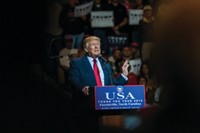Advertisement
Grab your lab coat. Let's get started
Welcome!
Welcome!
Create an account below to get 6 C&EN articles per month, receive newsletters and more - all free.
It seems this is your first time logging in online. Please enter the following information to continue.
As an ACS member you automatically get access to this site. All we need is few more details to create your reading experience.
Not you? Sign in with a different account.
Not you? Sign in with a different account.
ERROR 1
ERROR 1
ERROR 2
ERROR 2
ERROR 2
ERROR 2
ERROR 2
Password and Confirm password must match.
If you have an ACS member number, please enter it here so we can link this account to your membership. (optional)
ERROR 2
ACS values your privacy. By submitting your information, you are gaining access to C&EN and subscribing to our weekly newsletter. We use the information you provide to make your reading experience better, and we will never sell your data to third party members.
Environment
A Renewed Fight Against Climate Change
Greenhouse Gases: Obama promises executive order to cut emissions
by Jeff Johnson
June 28, 2013
| A version of this story appeared in
Volume 91, Issue 26

On a steamy day this week in Washington, D.C., President Barack Obama, in a forceful speech at Georgetown University, rolled out his plan to limit U.S. greenhouse gas emissions. He promised an executive order to cut those emissions with the goal of hitting a target of 17% below 2005 levels by 2020.
Since taking office in 2009, the President has warned of climate-change impacts, but his efforts to address the problem have been mostly on the margins—efficiency requirements and technical and financial support for advanced energy technologies. In his Georgetown speech, he presented a framework of specific actions aimed at reining in the energy industry, the source of 40% of U.S. carbon dioxide emissions.
Fossil-fuel industry advocates immediately criticized the President’s plan. They predicted pitched battles during the 2014 congressional elections because of the President’s continued “war on coal,” in the words of Senate Minority Leader Mitch McConnell (R-Ky.) and other Republican lawmakers.
Environmental groups were elated with the President’s climate agenda and his promise of action. As was American Chemical Society President Marinda Li Wu, who applauded Obama’s “tangible efforts to address global climate change.”
The United Nation’s top climate-change official, Christiana Figueres, said, “When the U.S. leads action, it also encourages more rapid international efforts to combat climate change by strengthening political trust, building business momentum, and driving new technology solutions.”
HIGHLIGHTS OF THE WHITE HOUSE PLAN
◾ EPA will repropose CO2 pollution emissions standards for new fossil-fuel power plants by Sept. 20, will propose standards for existing fossil-fuel power plants by June 2014, and finalize them a year later.
◾ Loan guarantees worth $8 billion will be offered for advanced fossil-fuel energy projects that avoid, reduce, or sequester greenhouse gas emissions.
◾ New wind and solar energy projects sufficient to meet electricity needs of 6 million homes will be approved on federal lands by 2020.
◾ New efficiency standards will be required for federal buildings.
◾ New federal programs will be introduced to better prepare states and communities for climate-change impacts.
◾ U.S. financial support for new overseas fossil-fuel power plants will end unless power plants are highly efficient or use carbon capture and sequestration technologies.
◾ Greater efforts will be made to reduce hydrofluorocarbon and methane emissions.
The President, in his address, described decades of climate-change science and a stream of scientific papers showing beyond-normal droughts, fires, and floods. For 97% of climate scientists, he said, the data have put doubts that climate change is real to rest.
“As a President, as a father, and as an American,” Obama told his young audience, “I’m here to say we need to act. I refuse to condemn your generation and future generations to a planet that’s beyond fixing.
“I’m here to enlist your generation’s help in keeping the U.S. a leader—a global leader—in the fight against climate change,” he continued.
The President said he would use executive office powers rather than seek congressional legislation to reduce greenhouse gas emissions. In this way, Obama will avoid wrangling with Congress, which has mostly opposed cutting greenhouse gas emissions and angering the fossil-fuels industry.
Nonetheless, any executive order on reducing greenhouse gas emissions that the President issues will be carried out by the Environmental Protection Agency, whose regulatory proposal and review process will provide ample opportunity for opponents of such measures to seek delays.
Obama’s actions will elevate the importance of the climate-change issue for all government activities. For example, the President singled out the State Department’s upcoming decision concerning the Keystone oil pipeline from Canada to the U.S. To gain U.S. approval to build the pipeline across U.S. borders, he said, the project cannot increase carbon pollution. The pipeline’s net effect on climate, he stressed, “will be absolutely critical to determining whether this project is allowed to go forward.”
However, the President assigned a special role for natural gas, citing methane’s lower CO2 emissions when used as a power plant fuel, despite being a potent greenhouse gas itself. Obama urged that the U.S. continue its reliance on natural gas by pursuing more drilling and use and by strengthening the country’s role as the world’s top natural gas producer—in the “medium term at least,” he said.





Join the conversation
Contact the reporter
Submit a Letter to the Editor for publication
Engage with us on Twitter